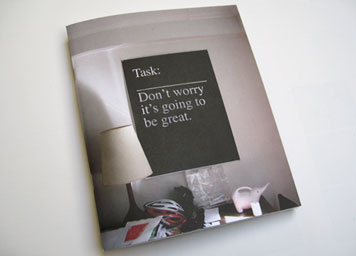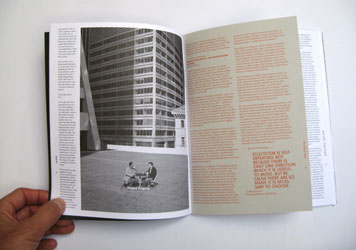
Cover of Task #1, designed by Emmet Byrne, Alex DeArmond & Jon Sueda, 2007
A large, black poster hangs on the wall with the reassuring statement: "Don't worry it's going to be great." Posted among the everyday clutter of someone's apartment, it looks like a warning label or a Post-It Note, but reads like a fortune cookie or a bit of self-help affirmation. The intended recipient of this ambiguous message is unclear: is it directed to potentially apprehensive readers or the publishers themselves?
This cover is the premier issue of Task, a self-proclaimed "newsletter" about graphic design published by a trio of designers hailing from Minneapolis (Emmet Byrne), Tuscon (Alex DeArmond, now in Arnhem) and Oakland (Jon Sueda). Although two of the three are (or were) designers at the Walker Art Center where I am the Design Director, it should be noted that I had no involvement in this publication other than some misattributed statements by me.
The theme of Task #1 is the "Eclectic Slide," represented mostly in what the editor-designers call the "spine," a series of interleafed pages of text excerpts about eclecticism that course through the issue. The rest of the content consists of interviews with an array of designers and articles about specific design projects. For instance, featured is the book design for Al Gore's An Inconvenient Truth and the Cat Lover's Against the Bomb calendar, letting us know that design — well, Powerpoint and a litter of kittens — helps keep climate change and nuclear catastrophe at bay. The immediate impression of Task is that it represents something of a cross between early Emigre magazine (in terms of its interviews, not its design) and the cultivated eccentricities of Dot, Dot, Dot (with which it shares certain editorial proclivities and ambitions). The presence of Task asks, How do you make a magazine for the post-critical, post-movement moment of contemporary graphic design?

Spread from Task #1, designed by Emmet Byrne, Alex DeArmond & Jon Sueda, 2007
There is an air of hesitation about the whole venture, an uneasiness or uncertainty, but it is unclear whether that belongs to the editors or to field at large. While most newly minted publications trumpet a manifesto, Task soft sells its purpose — "design as a perspective, designed objects as evidence of larger systems, and designers as researchers," a mélange of contemporary design tendencies. Even its designation as a newsletter seems to under promise (only to over deliver). The tentativeness extends to its initial theme of eclecticism — what topic could be more relative and tactically evasive? Of course, the immediate question such a publication provokes is: "Do we really need another graphic design magazine?" My knee-jerk answer is no, but then I think about what is available now. Most of the existing fare reflects mainstream sensibilities and few if any position themselves as exceptions to the rule. In this context, we desperately need alternative venues — spaces where design is not a noun but a verb, places where the work doesn't have to speak for itself because its designers can. But can Task be that place? Constrained by its budget or perhaps its editorial position, Task lacks the pictorial and chromatic thrill of its mainstream counterparts. Thus, Task is not for the reading averse. There is more text crammed into this initial offering than belies its seemingly compact 64 pages. Expecting illustrations of work? Better look elsewhere, perhaps online.
At first glance, it is somewhat surprising that a publication like this exists today in print form. With the proliferation of blogs, the ambient consciousness of instant messaging, and the social networking of the Web, one might have expected that the task of exposing new designers and their working processes would fall to the Internet — the triumph of digital immediacy and networking over the print world's delivery of yesterday's news today. Even the editors of Task seem aware of certain time-to-market problems, as evinced by their own declaration that the contents of their publication might have expired during the newsletter's lengthy 18-month gestation period, adding that "finding and marking the exact moment it 'spoiled' might be somewhat entertaining." Although the contents appear to have a longer shelf life, it seems beside the point. The real purpose of Task is its mere existence, its physical embodiment as proof of concept. While its mission provides an editorial framework, its ultimate task is seeking like-minded readers (a.k.a. subscribers) — the most fundamental work of publishing.
One of the legacies of print capitalism is the creation of "imagined communities," a term associated with Benedict Anderson, one of the leading scholars of nationalism. By imagined, Anderson means not a fantasized community, but a perceived one. An actual community is one where the members know each other. In situations where this is not physically possible we have imagined communities, where members share a language and whose existence may be posited but is nonetheless real. Interestingly enough, Task provides an example of an actual community. Kristina Bell writes about a group of designers, artists, and writers in the Bay Area that meets each Friday to have lunch and conduct a show-and-tell session — a kind of reverse swap meet where stories and opinions are exchanged and examples of graphic design are circulated. The legendary Jack Stauffacher acts as host and attendees vary, with a rotating group of regulars and an occasional guest. It is this loose-knit gathering of regulars and the regular promise of discourse that makes this kind of community so compelling. And, for a brief moment, we are allowed to enter that world — eavesdropping on conversations, getting the lay of the land from the author. Lest we imagine attending the gathering in person, the name of the restaurant has been strategically redacted. In the end, Task offers us a glimpse of such connection, only to reaffirm our distance from it. Perhaps this is the fate of all imagined communities.
